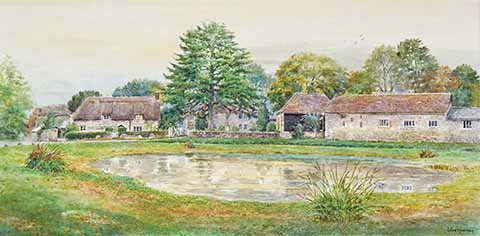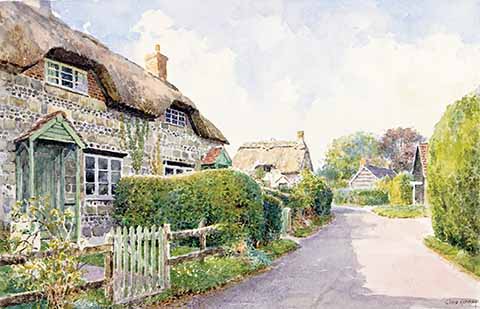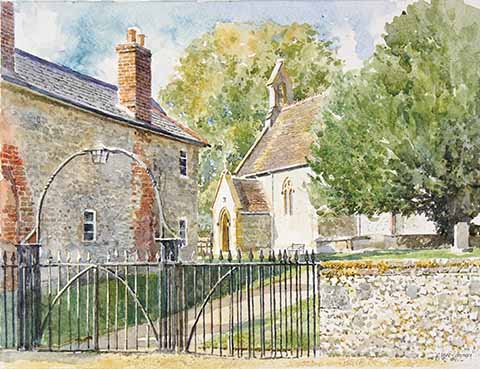Ashmore
Clive Hannay in Dorset’s highest village
Published in February ’19
 Its elevation of 700 feet, making it our county’s highest village, is perhaps the fact most often quoted about Ashmore. But it would be a dull place indeed if that was the only point of interest about it, and dull Ashmore certainly is not. If nothing else, its position means that it commands views over the rolling landscape of Cranborne Chase – on a clear day you can see the Isle of Wight – and in many ways it is a typical Chase village: hunting features large in its history, and today its farmers take advantage of the fertile downland that surrounds it.
Its elevation of 700 feet, making it our county’s highest village, is perhaps the fact most often quoted about Ashmore. But it would be a dull place indeed if that was the only point of interest about it, and dull Ashmore certainly is not. If nothing else, its position means that it commands views over the rolling landscape of Cranborne Chase – on a clear day you can see the Isle of Wight – and in many ways it is a typical Chase village: hunting features large in its history, and today its farmers take advantage of the fertile downland that surrounds it.
After its height, the village’s best-known feature is what Roland Gant calls its ‘duck-dappled pond’. Certainly the pond provides a village centrepiece to rank with any in Dorset. With the water table 300 feet down, the creation of a dew-pond, lined with clay, would have been necessary for any settlement to survive, and there is evidence that there was a pond here as early as 1000 BCE. Another theory has it that the pond is Roman: the Roman road from Badbury Rings to Bath passes within half a mile of Ashmore. Might the pond have something to do with the derivation of the village’s name: ‘the pool where ash trees grow’? The 40-yard-wide pond is not without its problems – algae recur quite frequently and from time to time the pond has to be emptied of tons of sludge, which is spread on the surrounding fields. Leakage is less of a problem since a membrane was installed in the 1990s.
 The pond is the centre-piece for the ancient custom of Filly Loo, which takes place on the Friday closest to the longest day, 21 June. The name is the first mystery: it has been suggested that it has a connection with the French words ‘fille’ (girl) and ‘l’eau’ (the water) but its origins are likely to pre-date by a long way the influence of French on the English vocabulary.
The pond is the centre-piece for the ancient custom of Filly Loo, which takes place on the Friday closest to the longest day, 21 June. The name is the first mystery: it has been suggested that it has a connection with the French words ‘fille’ (girl) and ‘l’eau’ (the water) but its origins are likely to pre-date by a long way the influence of French on the English vocabulary.
Ancient Filly Loo may be, but for a long time the ceremony fell into disuse and it was revived, primarily as a festival of folk dance, only in 1956. Led by a ‘Green Man’, the villagers process to the pond, where a circle dance around the Green Man signals the start of festivities. At the end of the evening, to the sound of a single pipe and a drum, girls with lighted torches lead men carrying antlers to the pond, where they perform a traditional horn dance. The participation of figures like the Turkish knight, the Fool and the Archer is a direct link back to the mummers’ plays of medieval times. But the roots of this ceremony go back much, much further than that, and its pagan undertones of eroticism and violence, along with the knowledge that the darkness will return when the torches that surround the pond are doused, send a shiver down the most unimaginative spine.
To the south-west of the village, the track through the northern end of Ashmore Wood, known as Washers Pit, was known by the locals to be haunted. The proof was the weird, unearthly sounds that could be heard in that part of the wood. The spirits that caused them were even given a name: ‘gabbygammies’ or ‘gappergennies’. When the track became a metalled road, the spirits presumably decided that their work was done, for they were never heard again.
There was a strong Methodist tradition in Ashmore, which is perhaps why the parish church of St Nicholas – almost opposite the former Methodist chapel, now a private dwelling – is a comparatively modest affair: no tower, no steeple, but a handsome bell-cote on the western end of the roof. There was a church here in the early 13th century, but it was re-built in 1423 and again by the enthusiastic Victorians in 1874.
 Apart from the 12th-century cauldron-shaped font, the two most notable features of the interior are 20th-century. In 1949, corbels were installed in the nave to illustrate ‘When pants the hart for cooling streams when heated in the chase’. This appropriate theme for a Cranborne Chase church was realised by John Skeaping (first husband of Barbara Hepworth) in 1949, and the style shows the influence that Eric Gill had on Skeaping’s work – these corbels could be seen as the latest extant example of genuine art deco. In the chancel is an engraved window of 1998 by Simon Whistler, son of Laurence, whose engraved windows in the parish church of Moreton are among the greatest works of 20th-century art in Dorset.
Apart from the 12th-century cauldron-shaped font, the two most notable features of the interior are 20th-century. In 1949, corbels were installed in the nave to illustrate ‘When pants the hart for cooling streams when heated in the chase’. This appropriate theme for a Cranborne Chase church was realised by John Skeaping (first husband of Barbara Hepworth) in 1949, and the style shows the influence that Eric Gill had on Skeaping’s work – these corbels could be seen as the latest extant example of genuine art deco. In the chancel is an engraved window of 1998 by Simon Whistler, son of Laurence, whose engraved windows in the parish church of Moreton are among the greatest works of 20th-century art in Dorset.
A walk of about 1¾ miles takes in the main features of the village, some of the surrounding fields and woods, and a taste of the views that the village offers.
Park on the road near St Nicholas’s church, which is on the edge of the village as you approach from the south-west, that is from the direction of Fontmell Magna and the Higher Shaftesbury Road. Enter the churchyard. Its top boundary is a wall with, towards the right-hand end, a patch of woodland. A careful search will reveal a rough path that runs through these trees to reach a stile. Cross the stile and turn right. Continue in the same direction along or across several fields until shortly after the last gate, the path becomes a track that leads to a T-junction. Turn right, then almost immediately right again onto the lane that runs down through the village.
Reaching the famous pond, turn left, then take the first turning on the left. Shortly, turn left on a track signed to Tollard Royal. Follow this past some stables and along the edge of a large paddock. In the first corner, turn right through a gate, then fork immediately right to follow a path that runs down through a wood. Where a field opens up on the right, stay on the path through the wood to
where it emerges onto an enclosed path with an open field on the right. Here go immediately
right, through a gate, and walk up the field to a low bank.
Here turn right, through a line of trees, and bear left to walk up to the far left-hand corner of a large field. Go through a gate just to the right of the corner and bear left up to a gate visible in the left-hand edge of the field. Walk along the track beyond to a lane, where turn right. Reaching on the left a house that was clearly some sort of church and has the datestone ‘AD1904’, double back to the left, go through a gate and turn right to walk along the right-hand edge of a field that gives magnificent views to the south-west. In the first corner, go through a gate and turn right up the right-hand field-edge. In the first corner, turn right on a track, then almost immediately right onto the road that leads back to your car.

